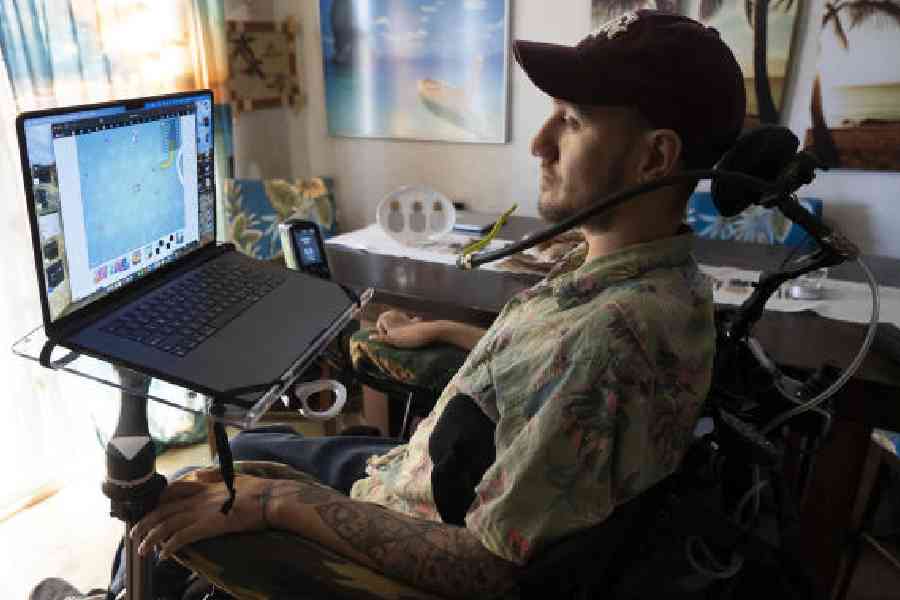Just four months ago, Noland Arbaugh had a circle of bone removed from his skull and hair-thin sensor tentacles slipped into his brain. A computer about the size of a small stack of quarters was placed on top, and the hole was sealed.
Paralysed below the neck, Arbaugh is the first patient to take part in the clinical trial of humans testing Elon Musk’s Neuralink device, and his early progress was greeted with excitement.
Working with engineers, Arbaugh, 30, trained computer programs to translate the firing of neurons in his brain into the act of moving a cursor up, down and around. His command of the cursor was soon so agile that he could challenge his stepfather at Mario Kart and play an empire-building video game late into the night.
But as weeks passed, about 85 per cent of the device’s tendrils slipped out of his brain. Neuralink’s staff had to retool the system to allow him to regain command of the cursor. Although he needed to learn a new method to click on something, he can still skate the cursor across the screen.
Neuralink advised Arbaugh against surgery to replace the threads, he said, adding that the situation had stabilised.
The setback became public a few weeks ago. And although the diminished
activity was initially difficult and disappointing, Arbaugh said it had been worth it for Neuralink to move forward in a tech-medical field aimed at helping people regain their speech, sight or movement.
From a small desert town in Arizona, US, Arbaugh has emerged as an enthusiastic spokesperson for Neuralink, one of at least five companies leveraging decades of academic research to engineer a device that can help restore function in people with disabilities or degenerative diseases.
Neuralink announced recently that it had received permission from the US Food and Drug Administration to continue testing implants in additional patients.
Arbaugh has been immobilised since a swimming accident. He became paralysed from the fourth vertebra in his neck down.
After the implant was embedded in late January, he began working long days with Neuralink staff members to link the neuronal patterns picked up in his brain to the actions he intended to take. He found the work tedious and repetitive, but rewarding.
Once the training was complete, engineers gave him control of the cursor on a computer. On his first day flying solo, Arbaugh beat a 2017 world record in the field for speed and precision in cursor control. “It was very, very cool,” Arbaugh said.
The long days of training computer models with Neuralink staff at his side have now been reduced to remote work in four-hour time blocks, Arbaugh said. The team continues to work on tasks like spelling words, as he envisions making sign language letters or writing on a chalkboard.
But the Neuralink device continued to lose its connection, the tendrils gradually sliding out of the tissue of his brain and presumably resting in the fluid that surrounds it.
When only about 15 per cent of the threads remained in place, Arbaugh lost command of the cursor altogether. Engineers recalibrated the computer programs to perform most tasks he had been able to do before. Because he can no longer get the system to do mouse clicks, he’s using a new tool that allows him to click by hovering a cursor over the item he intends
to select.
The flawed implant underscores the concerns of some experts in the brain-computer-interface field. The small, round device implanted in the skull is supposed to keep the thin tendrils of electrodes in place. But like a finger in a pie that’s wobbling about, the threads can pull out.
Arbaugh said his brain moved more than engineers had expected, and they have revised the surgical plan to implant the threads deeper in the next patient’s brain.
Arbaugh said his team had expected his brain to form scar tissue around the threads at the base of the brain — which they believed would help hold them in place. He said he will have the option to leave the study after a year but expected to keep working with the company longer. Neuralink has said the initial study will take about six years to complete.
Other leading commercial companies have taken different approaches.
Synchron, based in New York, US, has avoided the delicate tissue of the brain by going through a vessel to implant a tiny metal tube near the motor cortex of the brain.
Precision Neuroscience, based in New York, has implanted a flexible strip equipped with sensors on the surface of people’s brains and is reviewing the data it is gleaning from patients with the strip placed temporarily, Michael Mager, the company’s CEO, said.
Paradromics is testing its implantable device in sheep and expects to test it in humans in about a year, according to Matt Angle, the company’s CEO.
All of the work is closely regulated by the FDA, which weighs the risks and the benefits for procedures and is expected to first consider use of these devices in people with major disabilities or degenerative diseases.
Arbaugh hopes to see the technology deployed first to restore function in those who lost it.
“And then it can go to enabling people to enhance their capabilities,” he said, adding, “As long as we don’t give up our humanity along the way.”
NYTNS











